To smoke perfect sausages, you'll want to maintain temperatures between 225-250°F while monitoring internal temp until reaching 165°F. Start by drying your sausages at 140-150°F for an hour to form a protective skin. Choose hardwoods like oak or hickory, avoiding softwoods and toxic varieties. Space sausages evenly for consistent smoke exposure and use multiple temperature probes for accurate monitoring. Control humidity levels – 35% during reddening, 0% during drying, and 30-40% during cooking. Cool finished sausages immediately in cold water and look for a firm texture with reddish-brown color. Master these fundamentals, and you'll reveal the secrets of perfectly smoked sausage.
Proper Drying Makes Perfect Smoking
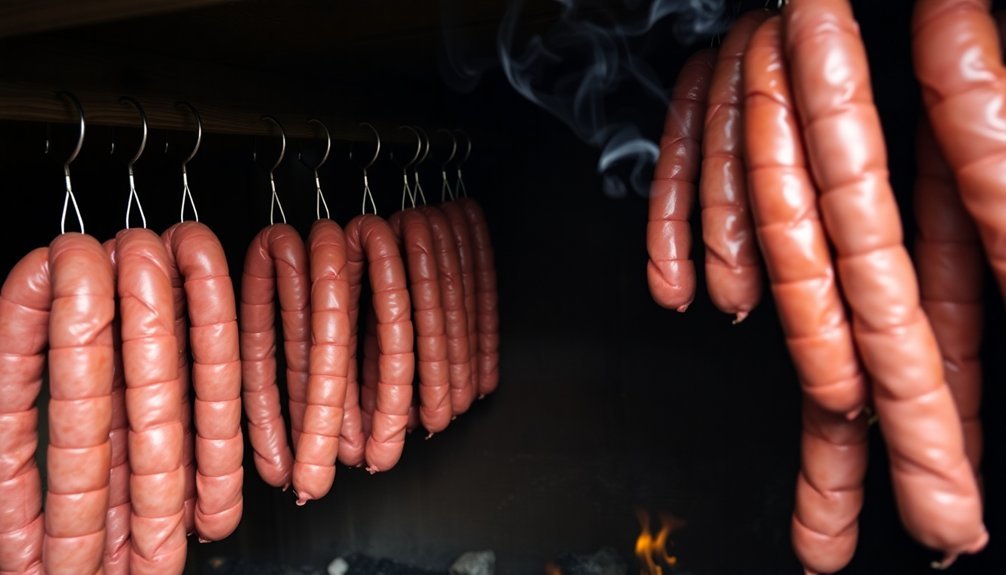
Before smoking your sausages, proper drying is vital for achieving the best results. You'll have two main options: air drying in a controlled environment or using your smoker at 140-150°F with the damper open. The smoker method is faster and more efficient, typically requiring about an hour to condition the surface properly.
When you're drying sausages, make sure moisture can escape by keeping the smoker's dampers open or the door slightly ajar. This step isn't just a formality – it's essential for developing a protective "skin" on the sausage's surface that will help it accept smoke evenly. The drying process will ensure you achieve even smoke color across all your sausages.
Proper drying also strengthens collagen casings and prevents an unsightly fat layer from forming between the meat and casing.
Once your sausages are dry to the touch, you're ready to increase the smoker's temperature and add your smoking wood. You'll know you've done it right when the casings feel tacky but not wet.
This preparation guarantees your sausages will cook evenly, maintain their casing integrity, and develop that perfect smoke adhesion you're looking for. Remember to maintain high humidity during the actual cooking phase to prevent the sausages from drying out.
Temperature Control Is Everything
You'll need to keep your smoker's heat zones steady between 225°F and 250°F for perfect sausages, using temperature alarms to alert you when adjustments are needed.
Managing your damper settings carefully helps prevent temperature swings that could dry out or ruin your sausages.
Position your temperature probes strategically throughout the smoker and in multiple sausages to guarantee even cooking and accurate readings.
Monitor the internal temperature until sausages reach a safe 160°F for proper doneness.
Maintain Steady Heat Zones
Mastering temperature control stands as the cornerstone of successful sausage smoking. You'll want to preheat your smoker to 225°F and maintain a steady temperature range between 200-250°F throughout the process.
Don't let temperatures drop below 180°F unless you're using cures, as this can promote bacterial growth. A typical smoking duration runs 60-70 minutes for most sausage varieties.
To maintain steady heat zones, you'll need to monitor both the smoker's air temperature and the internal temperature of your sausages. Install a multi-channel thermometer with high and low-temperature alarms to track these effectively.
Position your sausages with space between them to guarantee even cooking and prevent "bald" spots where casings touch.
Keep a close eye on temperature fluctuations, as they can greatly impact your results. If temperatures climb above 160°F too quickly, you'll risk melting the fat content, resulting in dry, crumbly sausages.
You're aiming for an internal temperature of 165°F for fully smoked sausages, but getting there slowly is key. Use your smoker's vents to control airflow and maintain consistent heat, and remember to turn your sausages periodically for even cooking.
Watch Those Damper Settings
Through careful damper management, you'll maintain the precise temperatures needed for perfect smoked sausages.
Keep your damper partially open to promote clean, blue smoke and prevent the thick white smoke that can ruin your sausage's flavor. You'll want to maintain steady airflow while keeping temperatures below 160°F to prevent fat from rendering out of your sausages.
Your damper settings directly affect both humidity and temperature control. Higher humidity helps cook your sausages more quickly and keeps the casings tender, while proper airflow guarantees even cooking throughout.
You'll need to monitor your damper more closely than you'd when smoking other meats, as sausages are particularly sensitive to temperature swings.
Start by drying your sausages at 140-150°F for an hour, which helps form a protective skin and guarantees even smoke absorption.
Once you've completed the drying phase, maintain steady temperatures through careful damper adjustments. When you've reached your target internal temperature of 155-165°F, cool your sausages immediately in cold water.
This stops the cooking process and helps preserve that perfect texture and snap you're looking for.
Probe Position Matters Most
Precision in probe placement can make or break your smoking session. You'll need at least two temperature probes: one for monitoring the smoker's ambient temperature and another for checking the sausage's internal temperature.
Position the air probe near where your sausages will hang, but not directly touching them, to get accurate readings of the surrounding smoke temperature.
For the meat probe, insert it into the centermost portion of the sausage. Don't settle for surface readings, as they won't tell you if the core has reached the critical 160°F (71°C) safe temperature. If you're smoking multiple links, verify that temperatures are consistent across all sausages.
Set up real-time monitoring with temperature alarms to maintain ideal smoking conditions between 225°F and 250°F (107°C to 121°C).
You'll want to place additional probes at different heights in the smoker to guarantee even heat distribution. Keep track of your readings throughout the process, and make adjustments as needed to maintain steady temperatures.
Remember to avoid placing probes near vents where readings might be skewed, and ensure proper natural convection for even smoke distribution.
Wood Selection Matters
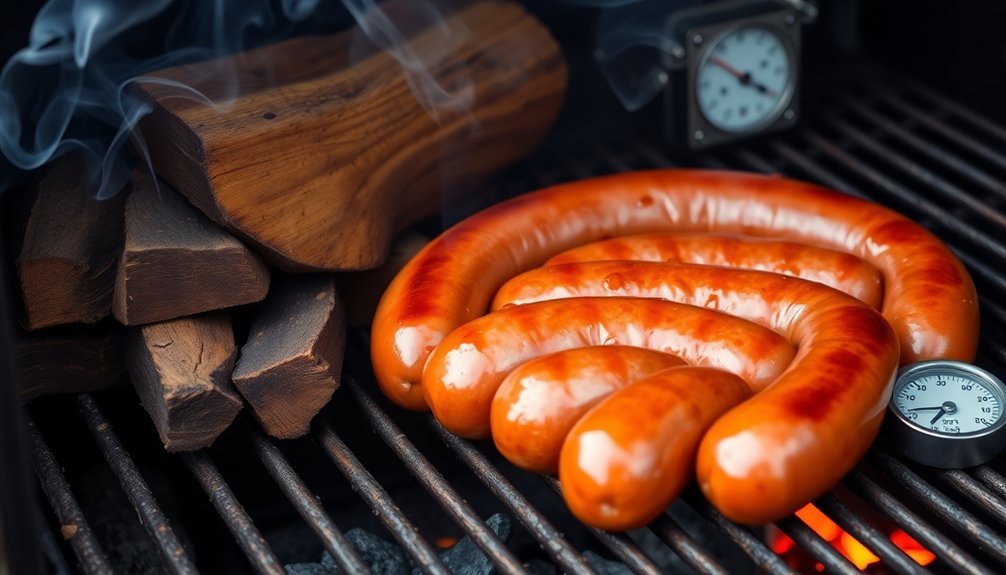
When smoking sausage, you'll want to stick with hardwoods like oak, hickory, or maple for reliable results, while fruitwoods such as apple and cherry can add subtle sweetness.
You'll need to avoid all softwoods, particularly pine and cedar, as their resins will make your sausage inedible and can damage your smoker.
For the best results, you can mix woods to create balanced flavors, such as combining strong hickory with mild apple wood to achieve the perfect smoke profile.
Best Woods For Flavor
Selecting the right wood for smoking sausage can transform an ordinary recipe into a mouth-watering masterpiece. For sausages, you'll want to focus on woods that complement rather than overpower your carefully seasoned meat.
Oak stands out as your most reliable choice, offering a strong but balanced smoke that won't overwhelm your sausages. You can't go wrong with hickory either, but you'll need to use it sparingly as its robust flavor can quickly become too intense.
For a milder touch, maple or cherry wood will infuse your sausages with a subtle sweetness that enhances rather than masks the meat's natural flavors.
If you're feeling experimental, try mixing woods to create your signature flavor profile. Combine oak with a fruitwood like apple or cherry for a balanced smoke that adds complexity to your sausages. Pecan also works well in combinations, adding a rich, nutty undertone that pairs perfectly with most sausage seasonings.
Avoid using mesquite or walnut, as they're too powerful for sausages and can leave a bitter aftertaste. Instead, stick with medium-strength woods or milder options that'll let your sausage's seasoning shine through.
Avoid These Wood Types
Safe wood selection makes or breaks your smoking success, and knowing which woods to avoid is just as essential as knowing which ones to use.
You'll want to steer clear of all softwoods like pine, cedar, cypress, fir, and spruce, as their high resin content creates unhealthy, sooty smoke that can ruin your sausages and pose health risks.
Don't use toxic woods such as sassafras, eucalyptus, elm, or oleander. These contain natural toxins and oils that can be harmful when burned.
Black walnut, despite being a hardwood, should also be avoided due to its toxic properties.
Never use lumber scraps, painted wood, or treated wood, as they often contain dangerous chemicals that can transfer to your food.
Keep green or fresh wood out of your smoker – it's full of moisture and will produce bitter-tasting smoke.
Watch out for moldy or fungus-covered wood, and always avoid plywood, which contains harmful adhesives.
If you're unsure about a wood's species, don't use it.
Some exotic woods like tambootie, yew, and mangrove contain natural toxins that make them unsafe for smoking.
Spacing For Even Smoke
Success in sausage smoking relies heavily on proper spacing between each link. You'll need to maintain at least 2 inches of space between sausages on your smoker's grate to guarantee proper airflow and even smoke distribution. This spacing prevents the links from touching each other, which can lead to uneven cooking and unwanted 'bald' spots where smoke can't penetrate.
When you're arranging your sausages, lay them on the grate so smoke can circulate freely around each link. Proper spacing helps maintain a stable temperature throughout your smoker and allows the smoke to reach all surfaces uniformly.
You'll want to avoid clustering the sausages, as this can block smoke flow and create hot spots.
Before you begin smoking, preheat your smoker to 225°F and verify you've got your water pan in place if you're using one. As you position your sausages, remember that proper spacing isn't just about smoke distribution – it's also essential for preventing overcooking and guaranteeing consistent results.
This careful arrangement will help you avoid wrinkled skins and maintain an even cooking rate throughout the smoking process.
Monitor Internal Temperature Closely
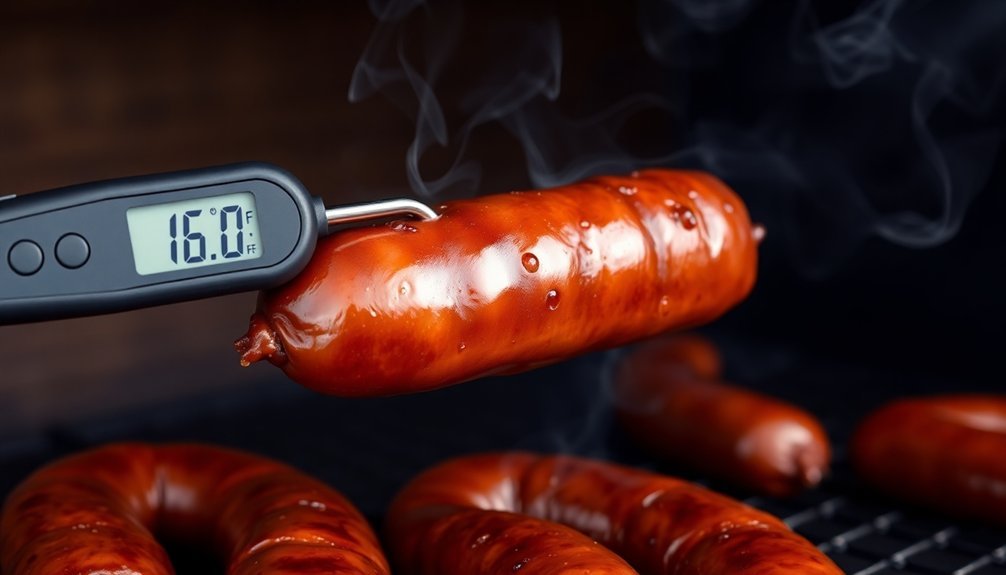
Your trusty meat thermometer becomes your most valuable tool when smoking sausages. You'll need to aim for an internal temperature of 160°F to 165°F to guarantee food safety and ideal texture. Don't rely on guesswork – insert your digital thermometer probe into the center of the sausage for accurate readings.
Monitor the temperature consistently throughout the smoking process, especially after the first 2-3 hours. You'll want to take readings from multiple sausages to confirm they're cooking evenly.
Keep your smoker's temperature steady between 225°F and 240°F for the best results. If you don't reach 160°F, you're risking harmful bacteria remaining in the meat. However, if you let the temperature climb too high, you'll melt the fat and end up with dry, crumbly sausages.
Once your sausages reach the target temperature, plunge them into ice water to set the casing and preserve the texture.
Remember to maintain consistent airflow by adjusting your smoker's damper as needed. This control helps you maintain the steady temperature that's essential for perfectly smoked sausages.
Maintain Consistent Airflow
Airflow stands as the cornerstone of successful sausage smoking. You'll need to guarantee proper ventilation throughout your smoking session by keeping vents open and maintaining consistent air movement.
If you're using a smoking cabinet, make sure there are openings at both the top and bottom to create a natural flow of air, and consider using a fan to enhance circulation during the drying phase.
When positioning your sausages, maintain a 2-inch gap between each one to allow smoke to circulate freely. You don't want them touching, as this creates spots where smoke can't penetrate.
If possible, hang your sausages from rods to maximize their exposure to smoke. For best results, arrange them from left to right to account for any temperature variations in your smoker.
Control your smoke flow by using a cold smoke generator with a spiral design, ensuring it has adequate airflow from underneath to keep the pellets smoldering properly.
Keep your firebox damper slightly open, and adjust your damper settings as needed to maintain the perfect temperature and smoke density.
Master The Humidity Balance
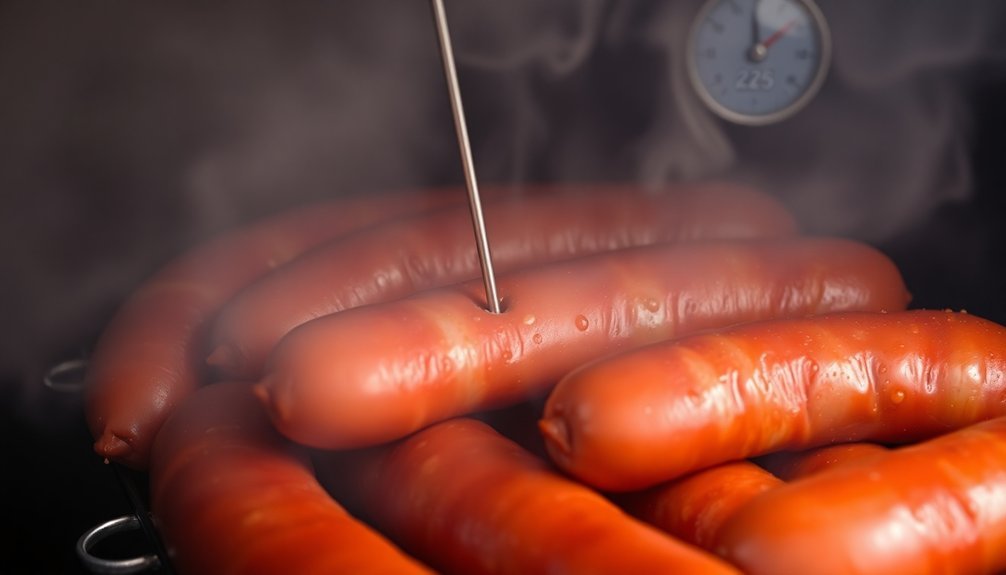
Precise humidity control forms the backbone of professional sausage smoking. You'll need to maintain relative humidity between 30-40% to achieve that perfect balance of smoke absorption and moisture retention. Using a water pan beneath your sausages serves two essential purposes: it stabilizes temperature and catches drippings while adding vital moisture to your smoking environment.
| Humidity Issue | Quick Solution |
|---|---|
| Too Dry | Add water pan or spritz with apple cider |
| Too Wet | Increase airflow and reduce water source |
| Fluctuating | Install automotive sponges in water pan |
| Uneven | Use Walton's humidity towel for consistent distribution |
| Hard to Monitor | Install wet/dry bulb thermometer system |
You'll know you've mastered humidity control when you see thin blue smoke consistently rising from your smoker. Monitor the sausage surface regularly – it shouldn't feel wet or dry to the touch. If you're smoking in a particularly dry climate, consider wrapping your sausages in butcher paper during the later stages of smoking. For precise control, use a psychrometer to measure relative humidity, and adjust your setup based on both ambient conditions and internal smoker readings.
Cooling Methods For Best Results
When cooling your smoked sausages, you'll want to start with an ice bath submersion for about 20 minutes to quickly halt the cooking process and set the casing.
You can then let the sausages gradually cool at room temperature, allowing them to dry completely while monitoring their internal temperature until they reach 110°F or lower.
To maintain the right balance during cooling, you'll need to control humidity levels by either air-drying the sausages or using paper towels to prevent excess moisture from affecting the final texture.
Ice Bath Quick Cooling
Right after smoking your sausages, an ice bath provides the most effective method for rapid cooling and ideal results. By quickly lowering the temperature, you'll prevent overcooking, maintain the casings' shape, and preserve the desired texture of your sausages.
Fill a large tub or pail with cold water and plenty of ice to create your cooling bath. You'll want to cool the sausages to around 120 degrees Fahrenheit as quickly as possible. If you're handling a large batch, consider using a garden hose to maintain a continuous flow of cold water, ensuring the bath doesn't become lukewarm.
Place your sausages in the ice bath immediately after removing them from the smoker. Keep them submerged until they've cooled sufficiently, then let them rest at room temperature for 30-40 minutes before refrigerating.
Don't skip this step by putting hot sausages directly in the fridge, as this can lead to souring and wrinkled casings.
Once they've completed the cooling process, dry the sausages with kitchen towels to remove excess moisture. You can then package them appropriately for storage, whether you're planning to refrigerate or freeze them.
Gradual Air Temperature Drop
A gradual cooling process offers an alternative to ice bath methods when smoking sausages. By allowing your sausages to cool slowly at room temperature, you'll develop a more intense flavor profile and achieve a slightly wrinkled appearance that many enthusiasts prefer.
This method works particularly well when you've maintained consistent temperatures throughout the smoking process.
You'll want to start by removing your sausages from the smoker once they've reached an internal temperature of 155°F. Place them on a clean, dry rack where they won't touch each other, allowing air to circulate freely around each link.
The key is to let them rest for several hours or overnight, which helps the casings dry completely and develop that desirable snap. During this cooling period, you'll notice the sausages gradually firm up as they return to room temperature.
If you're concerned about moisture retention, you can compromise between the ice bath and air cooling methods. Start with a brief period of air cooling, then finish with a quick water bath at around 170°F.
This combined approach helps maintain moisture while still developing that concentrated flavor you're after.
Humidity Control Methods
During the cooling phase, proper humidity control makes the difference between perfectly textured sausages and those with case hardening or moisture issues. You'll need to monitor and adjust humidity levels throughout different smoking stages to achieve ideal results.
Start by choosing the right time to smoke, avoiding high humidity periods and post-rain conditions. Before loading your sausages, heat up your smokehouse to eliminate ground moisture.
You'll want to maintain specific humidity levels at each stage: 35% during reddening at 50°C, 0% during drying at 60°C, and 30-40% during cooking stages between 100°F and 160°F.
To control humidity effectively, use a wet bulb-dry bulb thermometer for accurate measurements. If you need to increase moisture, place a wide water pan inside the smoker or spritz the meat with apple cider.
For precise monitoring, check the sausage's surface texture regularly – it should feel slightly tacky but not wet. Watch your smoke color too; you're looking for a thin blue line, which indicates ideal conditions.
Remember to keep your smokehouse well-insulated to maintain consistent internal conditions, and make sure the smokehouse temperature stays higher than the entering smoke temperature to prevent unwanted condensation.
Signs Of Perfectly Smoked Sausage

Looking for perfectly smoked sausage requires attention to multiple indicators, with internal temperature being the most critical factor. You'll need to ascertain the internal temperature reaches 165°F (74°C), which you can verify using an instant-read thermometer. This temperature guarantees both food safety and proper integration of ingredients.
While you're smoking, watch for a consistent reddish-brown color and slightly charred skin. Don't be fooled by a crispy exterior alone – it's not a reliable indicator of doneness. When you slice into the sausage, you should see a steamy or pink core, but avoid any with green, gray, or black spots.
You'll know your sausage is properly smoked when it feels firm and dry to the touch. The natural casing should be tender after cooling in cold water. If you notice any slimy or sticky texture, don't eat it – that's a sign of bacterial growth.
For best results, don't rely solely on visual cues. Always use your thermometer, and consume hot-smoked sausages while they're fresh. If you're cold smoking, remember that uncured sausages aren't safe to eat without proper heat treatment.
Storage For Long-Term Quality
Before storing, wipe off any excess moisture from your sausages to prevent spoilage.
Always use clean hands when handling sausage, and check for signs of spoilage before consuming.
Label your packages with the freezing date so you can track storage time.
For maximum freshness, store fresh sausages in the coldest part of your fridge.
If you're planning to keep them longer than a week, consider vacuum sealing them before freezing to maintain quality and prevent freezer burn.
Frequently Asked Questions
How Long Should I Soak Wood Chips Before Using Them?
You don't need to soak wood chips before smoking – it's actually counterproductive. Soaking only creates steam and delays smoke production. If you still want to soak them, 30 minutes is plenty of time.
Can I Reuse Sawdust or Wood Chips for Multiple Smoking Sessions?
You shouldn't reuse wood chips or sawdust for smoking. Once they're burned, they've lost their essential oils and won't produce the desired smoke or flavor. Always use fresh wood for each smoking session.
What Causes Sausage Casings to Become Tough and Chewy?
Your sausage casings become tough when you don't properly soak them, use incorrect water temperature, overcook them, or fail to puncture before smoking. Poor storage and using incompatible casing types also cause toughness.
Should Sausages Be Rotated During the Smoking Process?
Yes, you'll need to rotate your sausages during smoking to guarantee even cooking and smoke distribution. Rotate them every 30-45 minutes to prevent hot spots, maintain juiciness, and achieve uniform browning throughout.
Why Do Some Sausages Develop a Rainbow-Like Sheen After Smoking?
You'll notice rainbow colors on your sausages because the meat's structure diffracts light, while fats create thin-film interference. It's completely safe – just like the shimmer you'd see on a CD or DVD.
In Summary
You'll find that smoking sausage becomes second nature once you've mastered these essential techniques. From proper drying and temperature control to wood selection and spacing, each step builds on the last. Remember that monitoring internal temps and humidity while paying attention to cooling and storage will guarantee consistently great results. Now that you're equipped with these time-tested tips, you're ready to smoke perfect sausage every time.

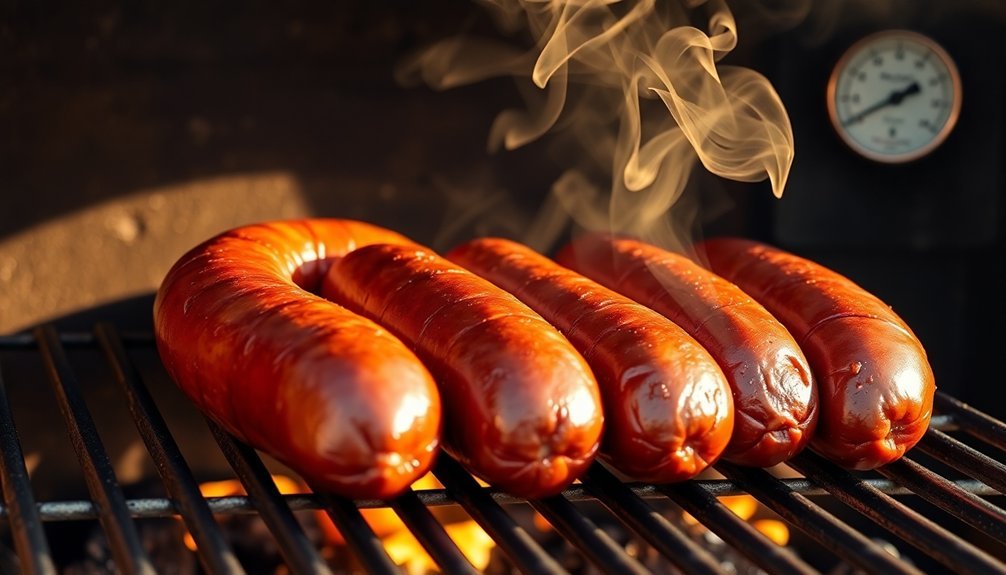



Leave a Reply